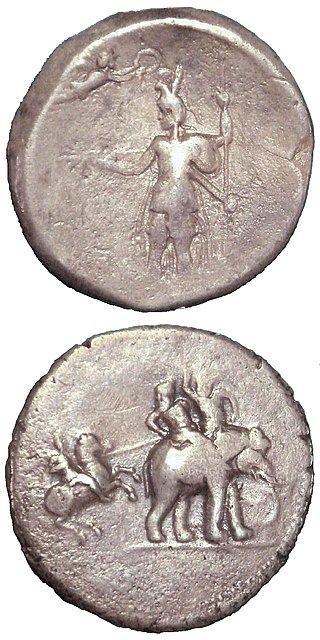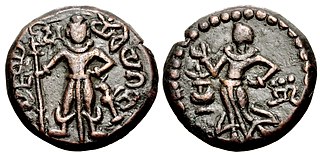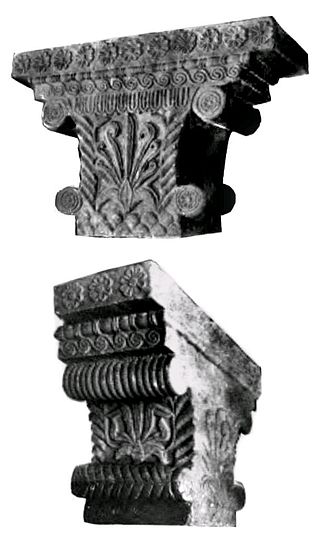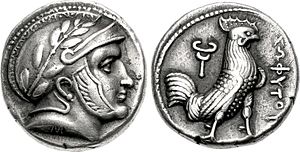
Demetrius I Anicetus, also called Damaytra was a Greco-Bactrian and later Indo-Greek king, who ruled areas from Bactria to ancient northwestern India. He was the son of the Greco-Bactrian Kingdom's ruler Euthydemus I and succeeded him around 200 BC, after which he conquered extensive areas in what is now southern Afghanistan, Iran and Pakistan and India.

Chandragupta Maurya was the founder of the Maurya Empire, based in Magadha. His rise to power began after the death of Alexander in 323 BCE, when at ca. 317 BCE he raised an army to resist the Greeks following a period of unrest and local warfare, defeating them and annexing Greek territory in the eastern Indus Valley. After insulting the Nanda king and ordered to be executed, he started a war against the unpopular Nanda dynasty, defeating them and establishing his own dynasty, "widely, and casually" dated at ca. 322-319 BCE, or "between c.311 and c.305 bc." According to Buddhist and Jain legends, he did this with help of his mentor Chanakya who later became his minister. He expanded his reach beyond the Ganges Valley into parts of the western Indus Valley and possibly eastern Afghanistan through a dynastic marriage alliance with Seleucus I Nicator in ca. 305-303 BCE, exploiting the power-vacuum that arose after Alexander's Indian campaign and his early death. His empire also included Gujarat, controlling a geographically extensive network of cities and trade-routes.

The Maurya Empire was a geographically extensive Iron Age historical power in South Asia with its power base in Magadha. Founded by Chandragupta Maurya between c. 322 BCE and c. 305 BCE, it existed in loose-knit fashion until 185 BCE. The primary sources for the written records of the Mauryan times are partial records of the lost history of Megasthenes in Roman texts of several centuries later, the Edicts of Ashoka, which were first read in the modern era by James Prinsep after he had deciphered the Brahmi and Kharoshthi scripts in 1838, and the Arthashastra, a work first discovered in the early 20th century, and previously attributed to Kautilya, but now thought to be composed by multiple authors in the first centuries of the common era.

The Indo-Greek Kingdom, also known as the Yavana Kingdom, was a Hellenistic-era Greek kingdom covering various parts of modern-day Afghanistan, Pakistan and northwestern India.

In ancient times, trade between the Indian subcontinent and Greece flourished with silk, spices and gold being traded. The Greeks invaded South Asia several times, starting with the conquest of Alexander the Great and later with the Indo-Greek Kingdom.

The Indo-Scythians were a group of nomadic people of Iranic Scythian origin who migrated from Central Asia southward into the northwestern Indian subcontinent: the present-day South Asian regions of Afghanistan, Pakistan, Eastern Iran and northern India. The migrations persisted from the middle of the second century BCE to the fourth century CE.

Zeionises was an Indo-Scythian satrap.

Rajuvula was an Indo-Scythian Great Satrap (Mahākṣatrapa), one of the "Northern Satraps" who ruled in the area of Mathura in the northern Indian Subcontinent in the years around 10 CE. The Mathura lion capital was consecrated under the reign of Rajuvula. In central India, the Indo-Scythians had conquered the area of Mathura from Indian kings around 60 BCE. Some of their satraps were Hagamasha and Hagana, who were in turn followed by Rajuvula.

Azilises was an Indo-Scythian king who ruled in the area of Gandhara circa 57-35 BCE.

Sodasa was an Indo-Scythian Northern Satrap and ruler of Mathura during the later part of the 1st century BCE or the early part of 1st century CE. He was the son of Rajuvula, the Great Satrap of the region from Taxila to Mathura. He is mentioned in the Mathura lion capital.

Sibyrtius was a Greek officer from Crete in the service of Alexander the Great, who was the satrap of Arachosia and Gedrosia shortly after the death of Alexander until about 303 BC.

Taxiles or Taxilas was the Greek chroniclers' name for the ruler who reigned over the tract between the Indus and the Jhelum (Hydaspes) Rivers in the Punjab region at the time of Alexander the Great's expedition. His real name was Ambhi, and the Greeks appear to have called him Taxiles or Taxilas, after the name of his capital city of Taxila, near the modern city of Attock, Pakistan.
The Western Satraps, or Western Kshatrapas were Indo-Scythian (Saka) rulers of the western and central parts of India, between 35 and 415 CE. The Western Satraps were contemporaneous with the Kushans who ruled the northern part of the Indian subcontinent, and were possibly vassals of the Kushans. They were also contemporaneous with the Satavahana who ruled in Central India. They are called "Western Satraps" in modern historiography in order to differentiate them from the "Northern Satraps", who ruled in Punjab and Mathura until the 2nd century CE.

Gangaridai is a term used by the ancient Greco-Roman writers to describe people or a geographical region of Bengal in the ancient Indian subcontinent. Some of these writers state that Alexander the Great withdrew from the Indian subcontinent because of the strong war elephant force of the Gangaridai.

Yaudheya (Brahmi script: 𑀬𑁅𑀥𑁂𑀬) or Yoddheya Gana (Yoddheya Republic) was an ancient military ganasangha (republic) based in the Eastern region of the Sapta Sindhu. The word Yaudheya is a derivative of the word from yodha meaning warriors and according to Pāṇini, the suffix '-ya', was significant of warrior tribes, which is supported by their resistance to invading empires such as the Kushan Empire and the Indo-Scythians. Rudradaman I of the Western Satraps notes in his Junagadh rock inscription that the Yaudheyas were 'heroes among all Kshatriya' and 'were loath to surrender'. They were noted as having a republic form of government, unique from other Janapadas which instead maintained monarchies.

Chashtana was a ruler of the Saka Western Satraps in northwestern India during 78-130 CE, when he was the satrap of Ujjain.

The legacy of the Indo-Greeks starts with the formal end of the Indo-Greek Kingdom from the 1st century, as the Greek communities of central Asia and northwestern India lived under the control of the Kushan branch of the Yuezhi, Indo-Scythians and Indo-Parthian Kingdom. The Kushans founded the Kushan Empire, which was to prosper for several centuries. In the south, the Greeks were under the rule of the Scythian Western Kshatrapas.

Around 535 BCE, the Persian king Cyrus the Great initiated a protracted campaign to absorb parts of India into his nascent Achaemenid Empire. In this initial incursion, the Persian army annexed a large region to the west of the Indus River, consolidating the early eastern borders of their new realm. With a brief pause after Cyrus' death around 530 BCE, the campaign continued under Darius the Great, who began to re-conquer former provinces and further expand the Achaemenid Empire's political boundaries. Around 518 BCE, the Persian army pushed further into India to initiate a second period of conquest by annexing regions up to the Jhelum River in what is today known as Punjab. At peak, the Persians managed to take control of most of modern-day Pakistan and incorporate it into their territory.

Hellenistic influence on Indian art and architecture reflects the artistic and architectural influence of the Greeks on Indian art following the conquests of Alexander the Great, from the end of the 4th century BCE to the first centuries of the common era. The Greeks in effect maintained a political presence at the doorstep, and sometimes within India, down to the 1st century CE with the Greco-Bactrian Kingdom and the Indo-Greek Kingdoms, with many noticeable influences on the arts of the Maurya Empire especially. Hellenistic influence on Indian art was also felt for several more centuries during the period of Greco-Buddhist art.

Kharapallana was an Indo-Scythian Northern Satrap who ruled around c. 130 CE.

























